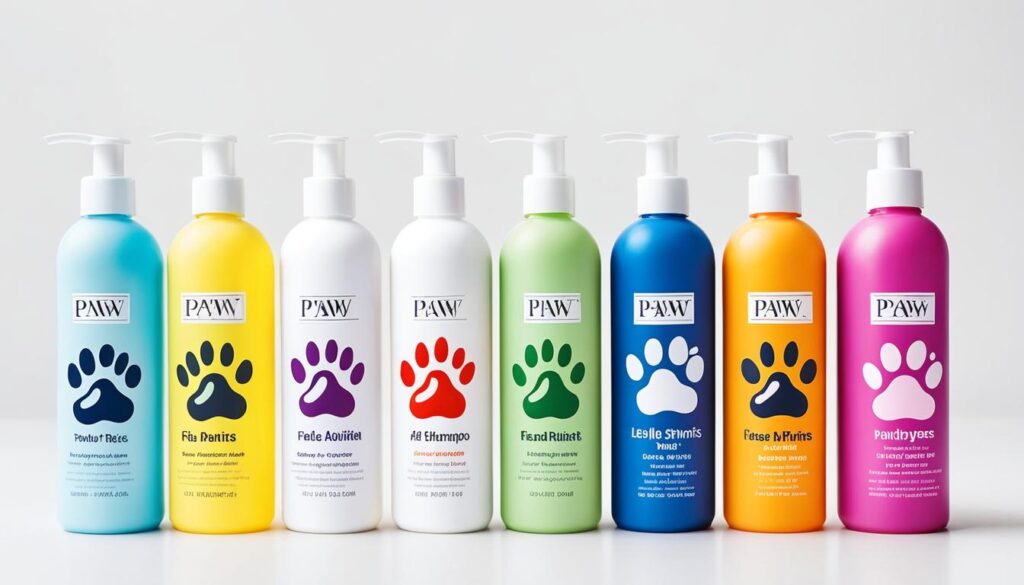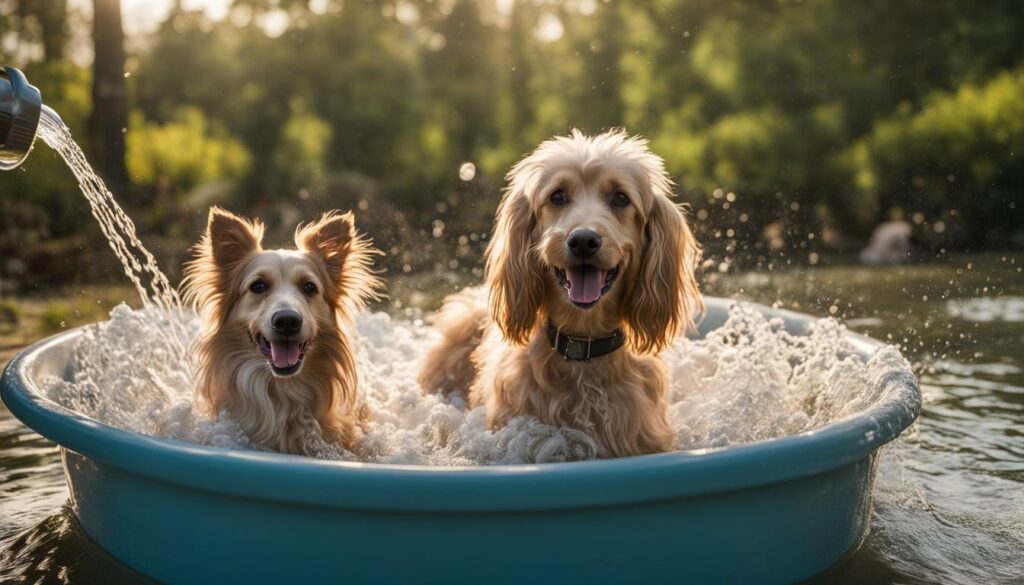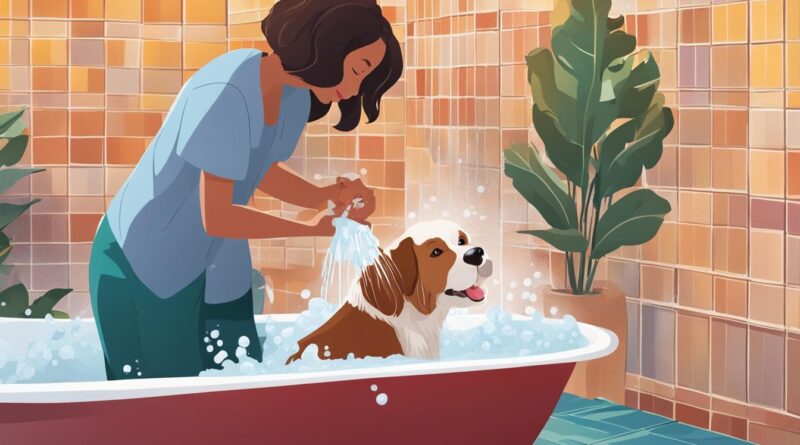Easy Dog Bath Guide: How to Bathe a Dog Safely
Welcome to our easy dog bath guide! Bathing your dog is an essential part of their grooming routine, and it doesn’t have to be a complicated or stressful task. In this article, we will provide you with helpful tips and techniques on how to bathe your dog safely and effectively. Whether you are a first-time dog owner or looking to improve your dog bathing skills, we’ve got you covered.
Key Takeaways:
- Use specially formulated dog shampoo with a neutral pH balance and no artificial colors or fragrances.
- Choose a suitable bathing spot, such as a sink for small dogs or a shower or bathtub for larger dogs.
- Reassure your dog and talk to them in a reassuring voice throughout the bath.
- Wet your dog’s body thoroughly with warm water before applying shampoo.
- Rinse your dog thoroughly with warm water to remove all soap residue.
Step-by-Step Guide to Bathing a Dog
Follow these easy steps to ensure a successful and stress-free dog bathing routine. By following best practices for dog bathing, you can make the process enjoyable for both you and your furry friend.
Step 1: Reassure Your Dog
Before you begin the bath, reassure your dog and speak to them in a calm and reassuring voice. This will help them feel more relaxed and comfortable throughout the bath.
Step 2: Brush Your Dog’s Fur
Brush your dog’s fur before the bath to remove any tangles or matted hair. This will make the bathing process easier and help prevent further matting during the bath.
Step 3: Test the Water Temperature
Ensure the water temperature is warm but not hot. Test the water on your wrist or forearm to ensure it’s comfortable for your dog.
Step 4: Wet Your Dog’s Body
Thoroughly wet your dog’s body with warm water, paying special attention to the underbelly and hard to reach areas. Use a handheld showerhead or a pitcher to make it easier.
Step 5: Apply Dog Shampoo
Apply a small amount of dog shampoo to your dog’s body and lather it in, avoiding the head and face. Use a shampoo specifically formulated for dogs to avoid skin irritation.
Step 6: Wipe the Face
Using a damp cloth, wipe your dog’s face to clean it, avoiding the use of soap or shampoo on the sensitive area around their eyes, nose, and mouth.
Step 7: Rinse Thoroughly
Rinse your dog’s body thoroughly with warm water to remove all shampoo residue. Make sure to rinse all areas, including the underbelly and paws, to avoid any potential skin irritations.
Remember to take your time during each step, ensuring your dog feels comfortable and safe throughout the bathing process.
Choosing the Right Products and Tools
When it comes to grooming your dog at home, selecting the right products and tools plays a crucial role in ensuring a successful bathing experience. By choosing the appropriate dog shampoo and having the necessary grooming tools on hand, you can provide your furry friend with a clean and comfortable bathing session.
Selecting the Right Dog Shampoo
Using shampoo specifically made for dogs is essential, as human shampoo can be harsh and irritate their sensitive skin. Look for dog shampoos that have a neutral pH balance and are free from artificial colors or fragrances. These gentle formulas will help maintain your dog’s skin health and keep their coat looking shiny and vibrant.
If you have a puppy, consider using a puppy-specific shampoo. These shampoos usually have a pH level that matches their eyes, preventing any discomfort or irritation. Consult your veterinarian or a professional groomer for product recommendations if you’re unsure which dog shampoo to choose.
Importance of Conditioner
In addition to dog shampoo, using a conditioner after shampooing is highly beneficial for your dog’s skin and hair. Conditioners help rehydrate the skin and coat, leaving it soft and moisturized. Look for conditioners that are specifically formulated for dogs and follow the instructions on the product label for best results.
Grooming Tools for a Successful Bathing Experience
Having the right grooming tools ready before bathing your dog can make the process smoother and more efficient. Here are some essential tools you should have on hand:
- A comb or brush suitable for your dog’s coat type to help remove tangles or mats
- Clean towels for drying your dog after the bath
- A non-slip bath mat or rubber mat to provide stability and prevent accidents
- An eye wash solution in case any shampoo accidentally gets into your dog’s eyes
By having these tools readily available, you can ensure a safe and comfortable bathing experience for both you and your dog.
| Grooming Tools | Description |
|---|---|
| Comb or brush | A tool to remove tangles and mats from your dog’s coat |
| Clean towels | For drying your dog after the bath |
| Non-slip bath mat | Provides stability and prevents accidents in the bathing area |
| Eye wash solution | Used in case any shampoo accidentally gets into your dog’s eyes |
These tools will assist you in achieving a thorough and efficient grooming session, leaving your dog feeling pampered and looking their best.
Now that you know how to choose the right products and have the necessary tools, you’re ready to give your dog a fantastic bathing experience at home.

Tips for a Positive Bathing Experience
Ensuring a positive experience during bath time for dogs is essential for their well-being. By following these dog bathing tips, you can make the process enjoyable and stress-free for both you and your furry friend.
Use Positive Reinforcement and Treats
Positive reinforcement is a powerful tool when it comes to dog bathing. Use praise, gentle words, and treats to create a positive association with bath time. Reward your dog for calm behavior and cooperation throughout the process.
Have a Partner for Support
“Having a partner can provide added support and safety during the bath.”
Some dogs may feel anxious or try to escape during bath time. Having a trusted partner hold your dog can provide them with a sense of security and prevent any accidents or injuries.
Start Bathing Your Dog as a Puppy
Introducing your dog to bath time when they’re still a puppy is beneficial for their long-term comfort. Gradually acclimate them to the bathing experience by starting with short and positive sessions. This will help them associate bath time with positive experiences as they grow.
Towel Dry or Use a Pet-Specific Hairdryer
After bathing, properly drying your dog is crucial to prevent discomfort and potential health issues. Use a clean towel to gently dry your dog’s fur, paying extra attention to areas that tend to stay damp. Alternatively, you can use a pet-specific hairdryer on a cool or medium setting to speed up the drying process.
Brush Your Dog While They Dry
Prevent mats and tangles by brushing your dog’s coat while they are drying. This not only helps maintain their fur’s condition but also allows you to spend quality time with your dog.
| Tips for a Positive Bathing Experience |
|---|
| Use positive reinforcement and treats |
| Have a partner for support |
| Start bathing your dog as a puppy |
| Towel dry or use a pet-specific hairdryer |
| Brush your dog while they dry |
Bathing Different Types of Dogs
When it comes to bathing dogs, different breeds and coat types require specific care. Understanding the unique needs of your furry friend can help you create a bathing routine that keeps them clean and healthy.
Bathing Dogs with Long Coats
Dogs with long coats often require more frequent baths and additional grooming compared to their short-haired counterparts. Their luxurious locks can easily accumulate dirt, debris, and odors. Regular bathing helps keep their fur clean and tangle-free.
To maintain the health and beauty of your dog’s long coat, it’s important to:
- Brush their fur before bathing to remove any tangles or mats.
- Use a gentle, pH-balanced dog shampoo formulated specifically for long-haired breeds.
- Rinse thoroughly to ensure all shampoo residue is removed.
- Dry their coat thoroughly to prevent moisture-related skin issues.
- Consider using a detangling conditioner to make brushing easier and prevent knots.
Consulting a professional groomer for specific recommendations and techniques can be valuable in maintaining the health and appearance of your dog’s long coat.
Bathing Different Dog Breeds
Each dog breed may have specific bathing needs, so it’s essential to consider their individual requirements. Certain breeds may have sensitive skin, allergies, or specific coat types that demand special attention during bathing.
- Consulting a groomer or veterinarian can provide insights into the best bathing practices for your dog’s breed.
- They can recommend suitable products and techniques that cater to your dog’s unique needs.
- Be mindful of any breed-specific instructions or precautions when it comes to bathing and grooming.
Always prioritize your dog’s comfort during bath time. Choose a bathing spot that suits their size and provides safety and stability. Swift adjustments in your bathing routine based on your dog’s health, coat condition, and lifestyle can ensure a positive and effective bathing experience.

Remember, every dog is different. By understanding the specific needs of your furry companion, you can tailor their bathing routine to keep them clean, healthy, and happy.
Benefits of Regular Dog Baths
Grooming your dog through regular baths offers numerous benefits that contribute to their overall health and well-being. Not only does bathing remove dirt, debris, and unpleasant odors from your dog’s coat, but it also helps maintain the health of their skin and fur.
Here are some key benefits of regularly bathing your dog:
- Healthy skin and coat condition: Bathing your dog helps remove excess oils, dead skin cells, and irritants that can accumulate on their skin. This promotes a healthier skin pH balance and reduces the risk of skin infections or irritations.
- Addressing skin conditions and allergies: A regular bath routine can be an effective way to manage certain skin conditions or allergies that your dog may have. Medicated or specialty shampoos can provide relief from itching, soothe irritated skin, and help control allergies.
- Dander reduction and minimized flaking: Regular bathing helps reduce the amount of dander, which is the tiny particles of dead skin that can cause allergies. By minimizing flaking, bathing contributes to a cleaner environment for both your dog and your family.
- Freshened and moisturized skin and coat: Bathing your dog helps remove dirt and odors, resulting in a fresh and pleasant-smelling pet. Additionally, using a moisturizing shampoo or conditioner can help keep their skin and coat hydrated, preventing dryness or itchiness.
Regular baths are an essential aspect of your dog’s grooming routine. Not only do they keep your dog clean and fresh but they also contribute to their overall health and comfort.
Comparison of Benefits
| Benefit | Description |
|---|---|
| Healthy skin and coat condition | Removes excess oils and dead skin cells, promoting a balanced skin pH and reducing the risk of infections. |
| Addressing skin conditions and allergies | Medicated or specialty shampoos can provide relief from itching, soothe irritated skin, and help control allergies. |
| Dander reduction and minimized flaking | Reduces the amount of dander and minimizes flaking, resulting in a cleaner environment and reduced allergy risks. |
| Freshened and moisturized skin and coat | Removes dirt and odors, leaving your dog smelling fresh, and using moisturizing products helps prevent dryness or itchiness. |
How Often Should You Bathe Your Dog?
When it comes to bathing your furry friend, finding the right bathing frequency can be a common concern. While maintaining your dog’s cleanliness is important, you also want to avoid over-bathing, which can strip their coat of essential oils.
So, how often should you bathe your dog? The answer depends on a few factors:
- Smell: If your dog starts to develop an odor, it’s a clear sign that a bath is needed. However, be cautious not to perceive their natural scent as unpleasant, as dogs have their distinctive smell.
- Visible Dirt: If your dog gets visibly dirty from outdoor activities, such as rolling in dirt or mud, it’s a good indication that a bath is necessary.
- Lifestyle: Consider your dog’s lifestyle and activities. Active dogs who love exploring outdoors may need more frequent baths compared to dogs who spend most of their time indoors.
Generally, bathing your dog once a month is sufficient for most dogs. However, there are exceptions:
- Longer-Haired Dogs: Breeds with longer hair or double coats, such as Golden Retrievers or Siberian Huskies, may require more frequent baths to maintain their coat’s cleanliness and prevent matting.
- Active Dogs: Dogs that frequently engage in outdoor activities, like hiking or swimming, may need more frequent baths to remove dirt, debris, and potential allergens from their coat.
When determining the bathing frequency for your dog, it’s crucial to consider their specific needs:
- Health: Dogs with certain skin conditions or allergies may require more frequent baths with medicated shampoos as recommended by a veterinarian.
- Coat Type: Different coat types require different grooming routines. Dogs with short coats or low-shedding breeds may not need frequent baths as their natural oils help keep their coat healthy.
- Specific Skin Conditions: If your dog has specific skin conditions like dermatitis or yeast infections, a veterinarian may recommend a specific bathing schedule to manage their condition.
Remember, regular grooming and brushing can help maintain cleanliness between baths. Brushing your dog’s coat helps remove loose hair, dirt, and tangles while distributing natural oils for a healthier coat.
By understanding your dog’s individual needs and adjusting their bathing routine accordingly, you can keep them clean, comfortable, and happy.
Conclusion
In conclusion, taking care of your dog’s hygiene doesn’t have to be a daunting task. By following the step-by-step guide and incorporating the best practices for dog bathing, you can ensure a safe and enjoyable bathing experience for both you and your furry friend.
Remember to start by choosing the right products, such as specially formulated dog shampoos and conditioners, to avoid any skin irritations. Providing reassurance and positive reinforcement during bath time not only makes it a pleasurable experience but also strengthens the bond between you and your canine companion.
Regular bathing, in accordance with your dog’s needs and lifestyle, helps to keep them clean, maintain a healthy coat, and contribute to their overall well-being. Additionally, grooming your dog at home allows you to monitor their skin condition, check for any lumps or abnormalities, and address any minor grooming needs between professional grooming sessions.
So, don’t hesitate to schedule regular bath time and grooming sessions for your dog. By incorporating these dog bathing tips and best practices into your routine, you can ensure that your furry friend stays happy, healthy, and looking their best.
FAQ
What kind of shampoo should I use to bathe my dog?
Use specially formulated dog shampoo with a neutral pH balance and no artificial colors or fragrances.
Where should I bathe my dog?
Choose a suitable bathing spot, such as a sink for small dogs or a shower or bathtub for larger dogs.
How can I ensure my dog doesn’t slip in the tub or sink?
Provide grip in the tub or sink with a towel or rubber bath mat.
What supplies do I need for bathing my dog?
Gather all necessary supplies, including clean towels, before starting the bathing process.
How should I reassure my dog during bath time?
Reassure your dog and talk to them in a reassuring voice throughout the bath.
Should I brush my dog’s fur before bathing?
Yes, brush your dog’s fur to remove tangles and matted hair before bathing.
How do I ensure the water temperature is safe for my dog?
Test the water temperature to ensure it’s warm but not hot before wetting your dog.
Where should I start when wetting my dog?
Wet your dog’s body thoroughly with warm water, paying special attention to underneath.
Can I use regular shampoo on my dog?
It’s best to use shampoo specifically made for dogs, as human shampoo can irritate their skin.
How often should I bathe my dog?
Bathing frequency depends on factors such as smell, visible dirt, and lifestyle, but generally once a month is sufficient for most dogs.


